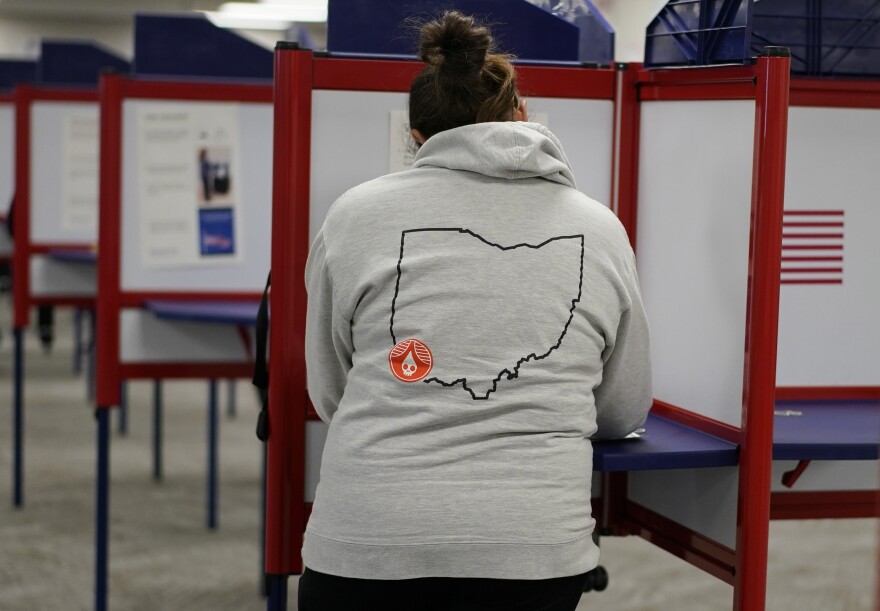There truly is no way of exaggerating how profoundly important the 2024 election is.
From a presidential contest that is literally a choice between continuing democracy and agreeing to autocracy, to state elections in Ohio that could result in breaking three decades of one-party rule, it matters.
All of it.
If you are an Ohio resident and can't find a good reason to vote in this fall's election, you're not really trying.
Here’s a taste of what Ohio voters face in the Nov. 5 election:
Ohio is Ground zero for U.S. Senate control

Democrats have held a slim two-vote majority in the U.S. Senate for the past two years, and that majority could flip over to the Republicans this fall.
Ohio voters will have a great deal to say about that.
On the ballot is Ohio's Democratic incumbent Senator Sherrod Brown, who is one of only two Democrats running for re-election in a state won by Donald Trump in 2020 — the other being Sen. Jon Tester of Montana.
Brown has been a survivor in Ohio politics since he first won election to the Senate in 2006, defeating Republican incumbent Mike DeWine, but this will be the most difficult race of his career.
He may, though, have caught something of a break last month when Ohio's GOP primary voters chose former luxury car dealer Bernie Moreno, the Trump-endorsed candidate out of a three-person field, to face him in November.
ANALYSIS: Bernie Moreno's win is good news for Trump and Ohio Democrats
Moreno carries baggage into the race — his anti-abortion rights views, his sometimes-sketchy business dealings, and some dubious claims about his family escaping socialism in Colombia when he was a child.
It will be a hard fight — and probably the most expensive Senate race in the country — but Democrats are counting on Trump's rather poor record of choosing Senate candidates.
J.D. Vance aside, if Trump were really good at it, Dr. Oz and Herschel Walker would be answering to the title Senator now.
Redistricting: The biggest thing not yet on the ballot

Chances are, if you have been outside walking about on busy sidewalks, you have been approached by people asking you to sign a petition for Citizens Not Politicians, backers of a proposed amendment to Ohio's constitution.
It is an amendment that would fundamentally change the way Ohio draws its legislative district lines to create more competitive districts and, possibly, break the three-decades-long Republican vise grip on the Ohio General Assembly.
The present rules, adopted overwhelmingly by Ohio voters in 2015 and 2018, have been a miserable failure — not because the rules are bad, but because the Republican majority on the Ohio Redistricting Commission wouldn't follow them.
In 2021 and 2022, an Ohio Supreme Court majority ruled seven times that the Republican-drawn maps were unconstitutional.
In response, the Republican majority ran out the clock and got what they wanted — districts that will preserve their veto-proof supermajority in the legislature.
What the Citizens Not Politicians amendment would do is this:
It would create a 15-member Ohio Citizens Redistricting Commission made up of five Republicans, five Democrats and five independents. Current and former politicians, political party officials and lobbyists are prohibited from serving on the commission.
LISTEN: Redistricting reform could be Maureen O'Connor's legacy if it makes it to the ballot
It would make it unconstitutional to draw maps that favor any political party or individual politician, and it requires the commission to operate under an open and independent process.
If the issue makes the November ballot, the Ohio Republican Party and its allies will fight this change with everything they have. It is a direct threat to the source of their power in the Ohio Statehouse.
Backers of the amendment have until the end of June to collect the valid signatures of about 413,000 Ohioans from 44 of the state's 88 counties.
With armies of volunteers pounding the pavement from one end of the state to the other, don't bet against them.
You will likely find this issue on your general election ballot.
Supreme decisions

In Ohio, complete one-party rule is not complete unless a political party controls a majority on the seven-member Ohio Supreme Court.
Conservative Republicans have four votes now and they are looking to expand that in the November election.
There are three seats up for election this year.
In 2021-2022, Democrats on the court had a de facto majority when then-Chief Justice Maureen O'Connor, a Republican, was voting with them to declare Republican-drawn legislative district maps unconstitutional.
But O'Connor couldn't run for re-election in 2022 because of Ohio's age limits law. Today, O'Connor is one of the leaders of the aforementioned Citizens Not Politicians movement.
Long-time Hamilton County Prosecutor Joe Deters was appointed by Gov. Mike DeWine to take O'Connor's vacant seat.
Deters is running this year, but not for the seat he was appointed to fill.
Instead, he is taking on an incumbent Democratic justice Melody Stewart.
RELATED: Here are your Ohio Supreme Court match-ups for November
Republican Megan Shanahan, a Hamilton County Common Pleas court judge, is running against a Democratic incumbent, Michael P. Donnelly.
The potential swing vote on the court could come from the matchup between Republican Daniel R. Hawkins, a Franklin County Common Pleas judge, and Democrat Lisa Forbes, an appeals court judge from Cleveland.
The bewildering part is this: We are well into the 21st century and we are still talking about partisan elections for judgeships.
And more...
Coming soon from yours truly: A look at the races closer to home.
In the meantime, make sure you are registered to vote in November by checking your status on the Ohio Secretary of State's website. If you find that you're not, you can register or update your address online — just be sure to do so by the deadline of Monday, Oct. 7.




